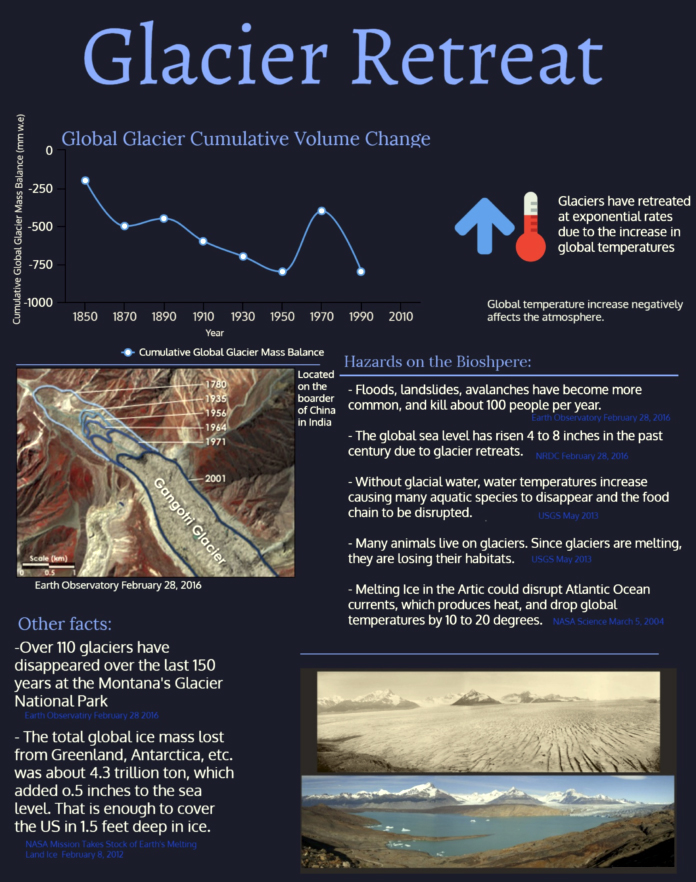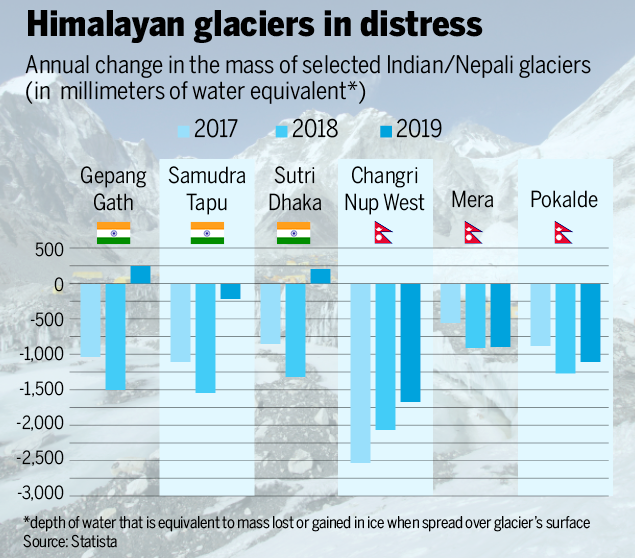Geography
Deglaciation and Threats
- 22 Feb 2021
- 8 min read
Deglaciation
- Glaciers, ice caps and continental ice sheets cover some 10% of the earth’s land surface at the present time, whereas during the ice ages, they covered about three times this amount
- The present ice cover corresponds to about three-quarter of the world’s total freshwater resources.
- The gradual melting away of a glacier from the surface of a landmass is known as Deglaciation.
- The processes that remove snow, ice, and moraine from a glacier or ice sheet are called Ablation.
- It includes melting, evaporation, erosion, and calving.
- The processes that remove snow, ice, and moraine from a glacier or ice sheet are called Ablation.
- The process of deglaciation, that intensified in the 20th century, is leaving our planet iceless.
Causes of Deglaciation
- Global warming: The atmospheric concentration of carbon dioxide, methane and other greenhouse gases (GHGs) produced by industry, transport, deforestation and burning fossil fuels, amongst other human activities, warm the planet and cause glaciers to melt.
- Ocean warming: Oceans absorb 90% of the Earth's warmth, and this affects the melting of marine glaciers, which are mostly located near the poles.
- Rapid industrialisation: Since the early 1900s, many glaciers around the world have been rapidly melting, specifically, since the industrial revolution, carbon dioxide and other greenhouse gas emissions have raised temperatures, even higher in the poles, and as a result, glaciers are rapidly melting, calving off into the sea and retreating on land.
Impacts of Deglaciation
- Raised sea level: The melting glaciers have played the major role in raising average global sea level between four and eight inches (10 and 20 centimeters) in the past hundred years, according to the Intergovernmental Panel on Climate Change (IPCC).
- Rising sea levels increase coastal erosion and elevates storm surge as warming air and ocean temperatures create more frequent and intense coastal storms like hurricanes and typhoons.
- On mountain glaciers: The famed snows of Kilimanjaro have melted more than 80% since 1912.
- Glaciers in the Garhwal region of the Himalayas are retreating so fast that researchers believe that most central and eastern Himalayan glaciers could virtually disappear by 2035.
- In the Northern Hemisphere: Spring freshwater ice breakup in the Northern Hemisphere now occurs nine days earlier than it did 150 years ago, and autumn freeze-up ten days later.
- Arctic sea ice has thinned significantly over the past half century, and its extent has declined by about 10% in the past 30 years.
- The Greenland ice sheet is disappearing four times faster than in 2003 and already contributes 20% of current sea level rise.
- Melting of Thwaites Glacier: Also called Doomsday Glacier, it is a 120 km wide, fast-moving glacier located in Antarctica.
- Because of its size (1.9 lakh square km), it contains enough water to raise the world sea level by more than half a metre.
- Studies have detected the presence of warm water at a vital point beneath the Thwaites glacier as the cause of its melting.
- Its melting already contributes 4% to global sea-level rise each year. It is estimated that it would collapse into the sea in 200-900 years.
- Studies have found the amount of ice flowing out of it has nearly doubled over the past 30 years.
- Disappearance of species: Glaciers are the natural habitat of a number of animals, both terrestrial and aquatic, if the melting continues at the same rate, a number of species will become extinct.
- It will also disturb the balance of the food chain.
The Himalayan Glaciers
About
- Himalayan glaciers form the largest body of ice outside the polar caps and are the source of water for the innumerable rivers that flow across the Indo-Gangetic plains.
- Himalayan glaciers are also known as the Third Pole.
- Himalayan glacial snowfields store about 12,000 km3 of freshwater.
- 15,000 Himalayan glaciers form a unique reservoir which supports perennial rivers such as the Indus, Ganga and Brahmaputra which, in turn, are the lifeline of millions of people in South Asian countries (Pakistan, Nepal, Bhutan, India and Bangladesh).
- The Gangetic basin alone is home to 500 million people, about 10% of the total human population in the region.
The Receding Glaciers
- Rate of receding: Glaciers in the Himalaya are receding faster than in any other part of the world.
- The glaciers have been losing the equivalent of more than a vertical foot and half of ice each year since 2000; double the amount of melting that took place from 1975 to 2000.
- According to the statistics in the last 25 years approximate 400 crore tons of ice being melted in the Himalayan glaciers.
- The 30.2 km long Gangotri Glacier has been receding alarmingly in recent years.
- Cause of receding: The receding and thinning of Himalayan glaciers can be attributed primarily to global warming due to increase in anthropogenic emission of greenhouse gases.
- The relatively high population density near these glaciers and consequent deforestation and land-use changes have also adversely affected these glaciers.
- Effect on the Hindukush region: Climate change has hastened glacial melting across the Hindu Kush Himalayan (HKH) region, home to some of the world’s tallest peaks, including Mount Everest.
- The recent glacier collapse at Nanda Devi in Uttarakhand’s Chamoli district led to a massive flood in the Dhauli Ganga river and caused large-scale devastation in the upper reaches of the ecologically fragile Himalayas.
- Air warming over HKH: Air over HKH warmed at a rate of 0.2℃ each decade from 1951 to 2014 and at an even higher rate of 0.5℃ per decade at elevations higher than 4,000 meters, as per a report prepared by the Ministry of Earth Sciences (MoES).
- The report projected that even with the Indian government’s commitment to mitigate greenhouse gases by 2030, the Indian Himalayas could warm by 2.6℃–4.6℃ by 2100.
- In the worst-case scenario, the mean surface temperature over the whole region could rise by 5.2℃ by 2100.








